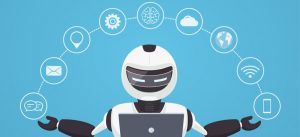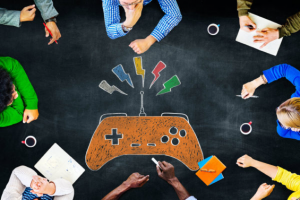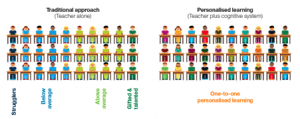Artificial Intelligence
From our perspective, the first emerging technology that has merit to support distributed and open learning is aritificial intelligence. In recent years, the application of artificial intelligence in the field of education has attracted much attention. With the development of information technology, artificial intelligence is becoming more and more popular, which also brings a lot of convenience to teachers and students.

Photo from UP to upgrade secondary school exam system with AI to make education corruption-free by Indo-Asian News Services
The development of artificial intelligence has brought us extremely rich educational resources, unprecedented powerful educational forces and rapidly improved educational efficiency, which can free teachers more time and energy to innovate educational content and reform teaching methods. At present, image recognition, speech recognition, human-computer interaction, and other artificial intelligence application technologies have been applied in the field of education. For example, through image recognition technology, artificial intelligence can liberate teachers from the heavy work of marking homework and marking papers; speech recognition and semantic analysis technology can assist teachers in oral English test evaluation and can correct and improve students’ English pronunciation. In open learning, AI can help teachers grade homework, so that teachers will have more time to teach children and answer their more detailed questions.
Educational Games
The second emerging technology we focus on is educational games, which are also closely linked to open learning. With diverse studying modes appearing, educational games are not strange to learners anymore. It is no doubt that the game is integrating into our lives, accompanying our growth, and now, participating in our education. No matter what cultures, games are regarded as general experience in human life (Ifenthaler et al., 2012, p. 1). The same goes for educational games: it can also be an entertaining experience in a human education career. What are educational games? As the name suggests, educational games are defined as those games designed for educational use or the games that have educational value. By involving with those games, people could gain knowledge within a specific domain, have a better understanding of content, and improve problem-solving skills(Ifenthaler et al., 2012).

Photo from https://www.eschoolnews.com/files/2017/08/gaming-600×400.jpg
Digitalization is the mainstream of current social development. Under such a situation, open learning is becoming common in education and familiar with people. However, self-learning is the most significant base of open learning. Studying effectiveness and performance varies from person to person. Generally, people with higher education levels would have better self-discipline and self-control ability than people with lower education levels, such as undergraduates versus pupils. Thus, educational games can be a highlight abstraction for some open learning classes, especially for lower-level education. The benefits of using educational games in open learning are unmeasurable, it can be attributed to teaching, entertaining, and assessing. The educational game is a good assistant which helps students to understand concepts better because it always comes up with images, sound, or animation. With the help of auxiliary games, students would understand learning content quickly and impressively. Moreover, educational games provide a condition where both relaxing for fun and reviewing learning content are taken into consideration. Self-learning depends on perseverance, interspersing with educational entertaining would increase students’ interest in learning and the perseverance can be maintained consequently. Furthermore, educational games can be designed as a short quiz, which tests the learning outcome. Thus, the use of educational games adds the diversity of open learning, enriching learner’s studying experience.
The SECTIONS model
How to choose and use multi-media in opening education appropriately? Iiyoshi et al. (2008) stated: “Design is a highly influential, value-laden and reflective practice which, within our context, must mirror, accommodate, and reconcile the values and assumptions intrinsic to open education”. The design in teaching is the crux to success in opening education. The purpose of chapter 9 “is to provide an effective decision-making framework for the selection and use of teaching media.” (Chapter 9) Here we have the SECTIONS model to evaluate the effectiveness of choosing and using media in open learning. The SECTIONS model stands for eight elements, and these elements are mutually reinforcing, which are students, ease of use, costs, teaching function, interaction, organizational issues, networking, and security and privacy. Then, we can use SECTIONS model to find the proper use of educational games in open learning.
Artificial intelligence
From the perspective of students, artificial intelligence technology can achieve personalized learning, so that each student can receive their own education. Students are different in learning basis, goal, method and other aspects. Artificial intelligence can record the data of students’ learning process, so as to generate the most suitable learning content and method for them and improve learning efficiency. By tracking and recording all the learning processes of students, we can find the difficulties and key points of learning, so as to help students adjust the learning process in time and customize the learning plan. In the traditional classroom, a teacher gives lectures to dozens of students. The content and progress of the lectures are not necessarily suitable for each student, so it is highly possible that some students have poor learning effect. The artificial intelligence classroom has changed the standard one-to-many teaching mode. Through the artificial intelligence technology, we can accurately collect the learning situation of each student and use big data analysis to carry out one-to-one personalized teaching for different students. Students can learn more pertinently and efficiently. AI can also solve the imbalance of educational resources. First of all, we must solve the imbalance of education teachers in different regions. The artificial intelligence classroom can give the teacher the distance education teaching, even in the remote mountainous area, through the intelligent equipment for students to watch teacher’s curriculum at any time, completely solving the problem of unbalanced education teachers.

Photo from How cognitive systems will make personalized learning a reality by Richard Cave
Jonathan, a computer scientist, has developed software that can correct English grammar. Unlike other similar software, it can understand the full text in relation to the context, and then make judgments, such as the subject-predicate agreement between various English tenses, singular, and plural, etc. It will improve the accuracy of English translation software or program translation and solve the communication problems between different countries. Photo search software, with the help of intelligent image recognition technology, gives students the access to use their mobile phones to arrange photos and upload them to the cloud when they encounter problems. And the system can give back answers and solutions in one to two seconds. These AI technologies bring many conveniences to students, and users can use intuitionistic to facilitate their navigation. The ease of use of AI in open learning helps teachers and students learn more efficiently, saves their time and improves their learning efficiency.

Photo from Technology reliability is important! from pixgood.com
“Computer technology can greatly facilitate learners’ interaction with learning resources.” (9.6 Interaction) Imagine a scenario in which a student is querying his final grade, he sees not only a simple score but also a “diagnosis report”. Through this report, he can not only understand the mastery of knowledge points and ability points of his own discipline but also see the discipline analysis of his strengths and weaknesses. Through these data for each student’s “portrait”, performance can be greatly improved. With the help of big data, it is convenient to diagnose the differences between students’ knowledge, ability structure and learning needs through the data statistics of students’ learning and growth process and effect, so as to help students and teachers get real and effective diagnosis data. Students can see the problem clearly and learn more efficiently; Teachers can also choose different teaching objectives and contents and implement different teaching methods according to the specific situation to further improve the pertinence, effectiveness, and science of teaching and learning.
Photo from Computers enable learners to interact with learning materials (also ‘inherent’ interaction)
Educational games
As the root of education, students are the most important element to teachers. They can be classified into different groups based on some standards. The instructors should know about target students before designing the class. As for educational games, it is obvious that the frequency of using games in a low level education is higher than a high level education, since older students would have a better receptivity than younger students do. To reach a greater efficiency, the content of educational games has no need to be much complicated. Instead, it should be simple and straightforward. If the target students are children, the game should focus on using funny images rather than profound vocabulary. The cost of using educational games may vary in different approaches. The medium of game is electronic equipment, such as a mobile phone or computer. However, designing an educational game is not a hard task. There are many animation websites which can design simple games, such as EDpuzzle. The emphasis of educational games is interaction, especially interaction with learning materials. As a type of interactivity, educational games can be defined as designed interactivity because the aim of using it is clear and well-targeted. Overall, educational game is suggested as a teaching assistant, not a necessity. It is useful to specific age group and learning content. The best way to use it properly is to correlate the background of target student with learning materials.
References
Ifenthaler, D., Eseryel, D., Ge, X., & SpringerLink Ebook Collection. (2012). Assessment in game-based learning: Foundations, innovations, and perspectives. London;New York;: Springer. doi:10.1007/978-1-4614-3546-4
Iiyoshi, T., Kumar, M. S. V., & Carnegie Foundation for the Advancement of Teaching. (2008). Opening up education: The collective advancement of education through open technology, open content, and open knowledge. Cambridge, Mass: MIT Press.
Chapter 9: Choosing and using media in education: the … (n.d.). Retrieved from https://pressbooks.bccampus.ca/teachinginadigitalagev2/part/9-pedagogical-differences-between-media/
Artificial intelligence. (2020, April 1). Retrieved from https://en.m.wikipedia.org/wiki/Artificial_intelligence
